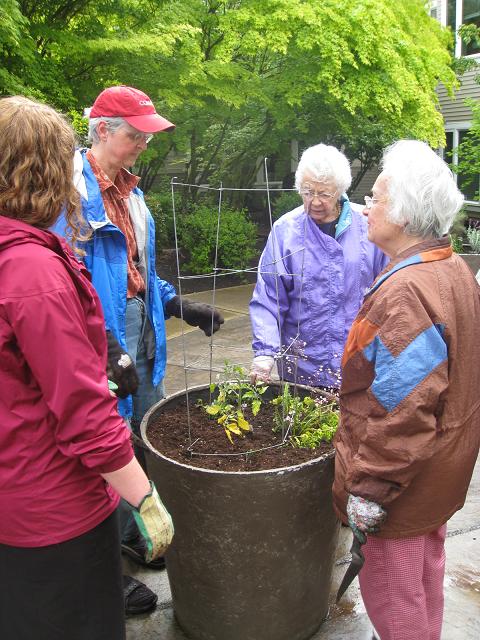Today’s blog is a continuation from last weeks Bring on the Green! Horticulture and Therapy. Cathi Lamoreux, CCC/SLP – an Infinity Rehab Director of Rehab – oversees rehabilitation services for several therapy departments in the Spokane, WA area. Cathi also has a certificate in Horticultural Therapy and is always finding ways to integrate creative therapy techniques to better suit individual patients. Recently, she has introduced horticulture into her sessions.
It isn’t really hard to figure out how to incorporate healthy gardening and nature activities into your practice. As with any activity, the hard part is often the prep prior to the session, accessibility, having the time to gather supplies and set up the activity, engaging others to help with transport, clean up and the list goes on.
I find that the pressures of productivity often cause us to become less creative and to stick with our tried and true exercises and activities. It isn’t that we don’t want to introduce something new or more creative, it is just that there isn’t a great deal of time to even think up something fun, meaningful and unique.
To inspire you to make the effort, here are a few benefits of gardening activities:
Physical
— Exercise the eyes through visual scanning, seeing near and far, and improving special relationships
— Exercise hands, fingers, arms and upper body
— Motivate the resident to walk, stoop, bend, reach and maintain balance
— Gives mild to moderate exercise in coordination, strength, stamina and physical activity when frequently nothing else will
— Gives enormous pleasure through the senses; seeing, smelling, feeling, tasting and hearing
— Motivates residents to use adaptive equipment as needed
— Provides pleasurable physical activity for those with physical disabilities or sensory impairments who wish to enjoy gardening in any setting
Cognitive
— Increases orientation
— Exercises the attention span
— Gives practice in following directions
— Exercises the mind in terms of memory, logic and safety judgment
— Increases interest in gardening and the natural world
— Teaches new skills and techniques in horticulture
— Stimulates understanding such abstract concepts as time, growth, death and change
— Gives greater awareness of living things around us
Social
— Promotes interaction by providing a common interest to discuss
— Improves social skills, self-esteem and confidence
— Gives practice in expressing opinions, formulating descriptions, asking questions, and exploring our sense of humor
— Helps residents learn more effective work attitudes and behaviors
— Motivates residents to work cooperatively with other people as a team
— Promotes healthy interdependence
— Lets residents explore horticulture as a hobby
— Lends itself to many social activities; clubs, garden socials, contests, special meals, cultural celebrations and parties
— Gives reason to go on field trips and getting to know the community better; garden-related businesses, greenhouse, nurseries, botanical gardens, parks and recreational gardens
Psychological
— Increases self-esteem
— Provides opportunities to relieve tension, frustration and aggression
— Promotes interest and enthusiasm for the future
— Provides opportunity for creativity and self-expression
— Success-oriented activity builds a “can-do” attitude
— Satisfies some of the client’s needs to be nurturing and caring
— Enhanced skills for greater independence
— Lifts the spirits of those who have little sense of purpose or hope through isolation and loss due to illness, accident, disease process, retirement or bereavement

Source: Cedar Sinai Park Blog
Here is a list of some great ideas that will help you get started with bringing horticulture into your therapy sessions:
Activity Ideas
— Planting seeds for fast growing plants such as wheat grass, marigolds
— Flower arranging while reminiscing about past gardens
— Take a bird walk and ID birds (keep count, discuss habitat, note different colors)
— Read seed & nursery catalogs – find your favorite flower and tell why
— Plant indoor bulbs – amaryllis, paperwhites, hyacinths
— Make centerpieces for the DR tables or a resident’s room
— Tomato tasting
— Cooking with herbs
— Using herbs as aromatherapy
— ID cones
— Plant a container with colorful annuals and/or vegetables on a patio where it can be viewed
— Watering and weeding of containers and/or gardens
— Garden mobiles
— Garden Party
— Plant trivia – hold “did you know” sessions, challenge residents to recall one piece of trivia and tell their tablemates or roommates and report back the next day
— Make herbal or lavender pillows
— Herbs – Growing and cooking with herbs
— Make holiday napkin rings using vines, leaves and dried flowers
— Water indoor plants
— Make painted rocks
— Make plant labels for plants in the garden and/or containers
— Recite poetry in the garden
— Make Tussie Mussies
— Valentine’s Day crafts
— Watch a gardening show or video and ask/answer questions
— Tend bird feeders
— Make a water garden
— Watch butterflies
— Match pictures of flowers, birds and/or butterflies to the real thing
— Make potato prints
— Order spring bulbs from catalogs
Being there when we see a breakthrough smile of someone who is depressed, watch for the first time when someone stands following an injury, or hear an aphasic resident speak makes it all worthwhile. Breaking out of our routines and trying something new is also rewarding as a therapist and reinforces why chose to do what we do.






